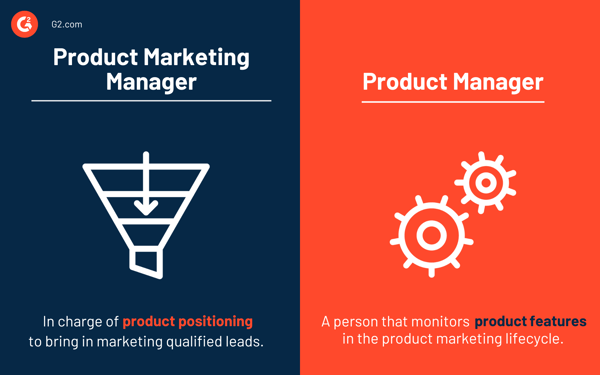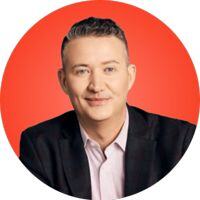October 30, 2023
 by Ray Slater Berry / October 30, 2023
by Ray Slater Berry / October 30, 2023

There’s been a definite shift into a more product-orientated world in recent years.
With a hyper-focus on product-led business comes a movement in the way they operate and how they prioritize growth strategies.
Once upon a time, we relied on traditional marketing and sales teams to champion products, and more recently still, we’ve seen the introduction of the aptly coined “customer success” teams – reducing customer churn by helping customers understand and make the most of their product.
Today, another shift is on the cards. Product marketing teams are seeing a surge in demand as businesses are realizing that a product-led strategy can help build, market, sell, and retain – excelling in all areas of a product’s lifecycle.
Businesses are stepping away from the spray and pray approach and focusing on more personalized, trigger-based campaigns with marketing automation software. Having a change of heart is rare, but the upheaval of software growth has made marketers realize it.
Product marketing is a combination of marketing efforts with the end goal of driving demand and sales of a company’s product or service. It is the start-to-end marketing journey of a product that underscores its importance in a competitive market.
Product marketing includes the tip and sole of a brand through website design, website content, promotional videos, traffic ads, lead gen campaigns, and go-to-market campaigns.
Product marketing is a flow in two directions: understanding the market and communicating the product.
Product marketing isn't just about finding your ideal consumer. It is a summation of how much you care about the customer. Forecast demand and then extrapolate on content distribution strategy. While targeting different prospects, product marketing focuses on three areas of communication:
By now, you should have an insight into what a product marketing team does and how they differ from and support other teams in a business. However, let’s dive a few feet deeper and look at a product team’s core responsibilities.
A product team needs to work closely with other teams across a business to coordinate a successful first launch of a product or new feature. They’ll unite marketing, sales, and PR to create as big of an impact as possible and ensure everyone’s communicating the product the same way.
We all know the importance of market research for sales and marketing – defining buyer personas and understanding the target demographic is Marketing 101. A product marketing team takes market research a step further and provides product-led insights to help build and shape the product itself and its communication to fit the marketplace better.
There are areas of the email marketing flow that are best left to the product marketing team. New product and feature release campaigns, customer onboarding, success journeys, and customer retention strategies are perfect projects for the team to head up.
The product marketing team can benefit other areas of the business, not only those that are customer-facing. Let the team guide the creation of sales collateral, one-page briefs, product demos, internal team training, and more. Think of areas or market segments within sales that need help, and let product marketing support them.
Whether you measure feedback quantitatively with smart user tracking tools or ask for feedback qualitatively with NPS micro surveys and other strategies, it makes the most sense for your product team to manage the collection of all this data and distribute the results where they see fit.
A product marketing team should be responsible for content creation for the product. It is not the responsibility of the photographer, designer, or videographer to entirely understand a product and its benefits. It’s their job to follow a detailed brief, and this is usually headed up by product marketing.
Solid onboarding is essential for customer retention metrics. An effective product marketing team is able to manage the expectations of new users, keep them engaged throughout that all-important starting 30-day period, and hold onto them for the long haul. Besides, something as small as a 5% increase in customer retention can increase profits from 25-95% – worth focusing on.
Webinars are traditionally hosted by customer success teams. However, product marketing teams have an ear to the ground with user struggles, customer churn, and product positioning, making them the perfect candidates to host webinars.
SaaS release notes showcase the hard work your product team is putting in behind the scenes. They also let your customers know you’re listening to their needs and are a positive opportunity for your business to touch base with users. Leave these with product marketing to make sure updates and new features are accurately represented in an appropriate, customer-facing way.
As you can see, a product team’s responsibilities don’t entirely fall within the marketing spectrum. Studies have found that although most product marketers report to marketing executives, there’s a growing trend in reporting to growth, product execs, or directly to CEOs.
 Source: Chameleon.io
Source: Chameleon.io
Now we’ve been through the responsibilities of a product marketing team; perhaps you’re kicking yourself thinking: “I need one of those,” but are unsure of where to start. Look no further.
This role leads the entire product marketing growth strategy. They handle budgets, project timelines, and the product manager’s workload. The candidate best for the role is someone who has experience in product design or research and customer-facing marketing. This role should report directly to the CEO and work alongside your Head of Marketing and Head of Sales.
Your PMM handles the day-to-day product marketing strategies; they’re given budgets to work with and may need to get scrappy with their resources to bring projects to life. This role manages data and content strategists.
Your content strategist is your biggest creator on the team and needs to be flexible with their skillset. Ideally, they’re able to write, design, or shoot fantastic content for each initiative. A jack of all trades; however, these skill sets are hard to come in just one person.
As your team grows and starts to prove how fantastic they are, you can start to build out new roles that are more specific to certain parts within the product life cycle and content creation niches.
Consider a sales enablement writer, end-user PMMs, a product videographer, a data strategist. All of these roles will bring a huge benefit to your product team’s overall success.
Lastly, on this point, it’s important to build a cross-functional team that maintains relationships with other teams within the business. It can be easy to work in silos when you have individual or team goals on the table. However, a product team truly shines when it collaborates with sales, growth, biz dev, and marketing.
Traditional marketing teams focus on demand generation; they are the drivers behind generating leads and supplying a wealth of hot, qualified leads to your sales teams. However, their resources need to come from somewhere; this is where product marketers come in.
Product marketing teams work alongside traditional marketing teams to better position the product within its target demographic. They create content and provide insights for content creation to ensure the product is communicated accurately and highlights its most useful features for the audience.
It’s good to think of product marketing as the backbone of any marketing team. Without them, there would be no content to drive leads, and a marketing team runs the risk of miscommunicating a product or losing time in creating content to convey it accurately. A product marketing team provides the material; the marketing team innovatively distributes it.
Two very similar-sounding roles, with some crossover but very different purposes: 
The two managers may often work from the same data points, but what they do with this data is very different.
A product marketing manager will look at the user onboarding journey, and the information a customer is or isn’t receiving could be a catalyst to them leaving. They may also look at user expectations and decipher if a product is not meeting them because of inaccurate messaging.
If a product was producing a high churn rate on day three of user onboarding, a product manager might look at what is happening with the physical product on that day. Perhaps there’s a bug, perhaps it’s not performing as promised, or maybe there's room for improvement.
It’s so important that these two roles work side-by-side. Not only because they’re sharing data but also because each will have access to data that the other won’t, yet will certainly benefit both of their work.
If you’re still unconvinced that your business needs a product marketing team, we’re about to change your mind. There are a ton of benefits to prioritizing product marketing for business growth.
Traditional marketing teams have toolkits that can give insights into your online brand sentiment and popularity: social listening tools, Google Analytics, and data visualization platforms all help gauge how people feel towards your business. At the same time, product teams have resources to understand how someone interacts with your product, like heatmaps, in-app surveys, and user recording tools.
Yet product marketing teams have insights into how people feel about interacting with your product. Using a collection of customer interview techniques, user research, and in-product feedback tools, product marketing teams have the power to conduct and act upon valuable data to help win, retain, and understand your customers.
Product marketers are in the prime position to ensure your personas resonate with your brand messaging. Using customer development surveys, they can understand how valued your product is with users and transform this data into actionable ways to position your product in the market better.
Businesses that have prioritized product marketing have proven to grow revenue by up to 50% a year. That’s a massive step up for your product sales and overall business growth. It’s reassuring to know your expenditures on product marketing can pay themselves back within the first year of implementing a product marketing strategy.
How can product marketing take revenue up by such a drastic amount? In short, it can help find gaps in sales enablement content that will better equip your sales team with the resources they need to convert leads.
Using in-depth competitor research, product marketers can identify the areas in your product and communication fall short in comparison to competitors. However, it’s not all doom and gloom; they’ll also be able to highlight where you’re winning.
If communicated well, this feedback will allow a multitude of teams to either position themselves better when facing customers or identify areas within their work that have room for growth.
Look at your product marketers as your direct reference point for consumer feedback and as your competitor knowledge hub. They can be a vital resource for more than marketing.
It’s not uncommon for businesses to have product, marketing, and sales teams that work in silos. Each team looks after its responsibilities and perhaps can be a little too quick to point the finger should company KPIs not be met each quarter.
“Well, marketing didn’t provide us with hot enough leads.”
“Yeah, but sales don’t showcase the product accurately.”
“Actually, product didn’t tell us about the new feature, and now it’s too late.”
Haunting, finger-blaming statements that hopefully you haven’t witnessed and shouldn’t need to, but also help to make the point.
A product marketing team builds bridges between these three departments; they can help drive product changes, advise sales on strategic content and wins, and help marketers focus their efforts to get more leads. They can do all of this with a holistic view of business growth goals and tie team KPIs to each other, uniting wider goals and their teams.
So we’ve got all of these fantastic benefits a product marketing team can bring to your business. How do you turn these benefits into a reality and create a product marketing strategy that works? It’s time to create a repeatable formula you can use for each product or feature so you can enjoy the outcomes and start profiting from your efforts.
First on your hit list is to define your personas. Who are you talking to, and why do they need your product? Get a clear idea of their pain points and motivations.
Once you’ve understood this, you can start to flesh out your personas. Give them names, ages, hobbies, the works. Every member of your team needs to understand and visualize who your customer is and what they need.
The second focus in your product marketing strategy checklist is product messaging. Why is your product the best in the market, and where does it stand amongst your competitors?
This is not just so your marketing team can portray the product in its best light. It’s also to equip the sales team to defend the product and better sell it. Lastly, this product alignment stage helps to inform the product team so they can continue to work on creating the best version of your product possible.
KPIs differ drastically, depending on your business growth goals. Make sure your product marketing KPIs match up and align with the business mission goals. Are you looking to build product engagement? Are you looking for more leads to win conversions? Perhaps you’re looking at improving the company's bottom line.
Whatever KPIs you set will determine the targets the head of product marketing is chasing with her or his strategy and give a clear idea of where they should prioritize their efforts.
Next up, it’s time to set your pricing structure. This is best informed by competitor research and aligning with your business development team to identify the margins you need to meet to be a healthy and profitable company.
Is it normal to build some sort of freemium version of your product to prove its value before introducing a paid-price plan with more benefits? Think of low-lift ways to get your product in someone’s hands – or on someone’s screens – to win them over and convince them to invest.
This is a huge step in your product marketing strategy and one that needs a lot of time if you’re going to launch well. You’ve already identified your product's pain points, its competitive differentiators, and its messaging for personas. Now, you’ve got to put all of that research into action and create some content.
Nothing builds trust and brand affinity like quality content. Keep this in mind as you go about creating. Plus, make sure you create for specific channels. There’s no use building content with ratios that don’t work or are not practical for where your target demographic is sitting or where you’re publishing your work.
Identify niche channels and content avenues in relation to your demographic, then create content that attracts, converts, and retains customers specifically for that avenue.
Next, you’re ready for the most exciting part of your strategy: launch day.
It’s a good idea to run a soft launch of your product or feature internally. Be that with your team or existing users. This softer launch will give you an idea of how your new feature or product is received, if your messaging has its desired effects, and will highlight any tweaks you may need to make before going to the masses and acquiring new leads.
A few brands have really nailed product marketing, whether it's for adapting to their customer needs, finding and showcasing a competitive edge, or simply nailing product messaging. Let’s explore those that are doing it best.
A 2020 report revealed Mailchimp covers 60% of the email marketing industry, and its closest competitor holds 9.3%. How did they do it? In an interview with Forbes, Mailchimp Chief Marketing Officer Tom Klein spoke of a recent acquisition.

He said: “We’re a purpose-driven company, and we really mean it, which means we are very dedicated to making our customers more successful.” Mailchimp’s dedication to making their customers more successful, rather than focusing on acquiring new ones, led them to shift their messaging and rework their personas.
Over the years, Mailchimp went from “Send better emails” to “Smarter marketing for big ideas” and “Do it all with Mailchimp.” They created tag lines that better resonate with their personas, small to medium businesses (SMBs), rather than the corporates they used to chase.
The beauty brand Billie quickly shot to stardom by identifying its product differentiation and running with it. They became the first beauty brand to celebrate culturally implied “imperfections.”
Billie shows body hair in their product marketing and celebrates diversity across all spectrums – designed for anyone who identifies as female. In their most recent campaign with PrettyBird UK, they published a video that encouraged a world in which people stop apologizing for their appearance and start owning it.
Their vision is heartwarming, and their competitor research and brand differentiation in product marketing see them go from strength to strength.
Just because brands tell you we’re in a visual-first world doesn’t necessarily mean your product niche is. Hey.com broke the traditional home page rules for years upon launch. Their product marketing team did their homework, identified their audience, and created content that appealed to that audience – not what other businesses told them they should be doing.
The result? An all-text homepage. No hero image, no video, just fantastic copy. Why? Because they realized that this is what would resonate with their customers.
Hey.com took a risk but accurately showcased their product in a content format their audience is familiar with while showcasing their product as a solution. Why? Because “email sucked for years,” and Hey.com are out to change that.

The chances are you had a Zoom call at some point in 2020. The year saw a drastic change to remote work across all businesses; some were ready for it, some were not – most turned to Zoom to keep their culture and communication thriving.
Zoom showcased exceptional product marketing agility in 2020. Zoom’s product was no longer for remote-first companies; it was for everyone. It meant their traditional personas were quickly joined by an onslaught of new customer types: teachers, therapists, gym instructors, and even the royal family. Zoom had to accommodate everyone, and some were not as tech-savvy as others.
From The Queen and The Royal Family this #InternationalNursesDay: Thank you 🌎 pic.twitter.com/YZvREWRlR9
— The Duke and Duchess of Cambridge (@KensingtonRoyal) May 12, 2020
Yet the company prevailed. At its peak, Zoom counted 300 million daily participants and was predicted to take $1.8bn by the end of 2020 – around double its original forecast in March of the same year. They even built and launched a new product, Zoom for Home, and for all of this, are the perfect example of agile and rapid product marketing.
There’s no questioning that product marketing should be an essential department within your business and can be a key player in your business growth. If they’re to be successful, product marketing teams need to be cross-functional, agile, and data-minded both in long and short-term strategies.
There’s certainly a mountain of benefits that come with onboarding a product marketing team and product marketing strategy. It’s important to build yourself a repeatable success recipe, hire great talent, and don’t be afraid to take data-driven risks if you want to own your industry niche.
Voice your value proposition so that your competitors don't monopolize your product. Learn the best ways to place yourself in line with consumer demand.
This article was originally published in 2020. It has been updated with new information.
Ray Slater Berry is a freelance writer for Chameleon with over nine years of content marketing and social media experience. He specializes in product tech, travel, and SaaS. Ray is also a published fiction writer, with his first novel Golden Boy.
For SaaS vendors, customer voice is a powerful lever to pull in your go-to-market (GTM)...
 by Eric Gilpin
by Eric Gilpin
It’s not easy being the new kid.
 by Alexandra Vazquez
by Alexandra Vazquez
Companies put a lot of effort into marketing their brands.
 by Sujan Patel
by Sujan Patel
For SaaS vendors, customer voice is a powerful lever to pull in your go-to-market (GTM)...
 by Eric Gilpin
by Eric Gilpin
It’s not easy being the new kid.
 by Alexandra Vazquez
by Alexandra Vazquez


